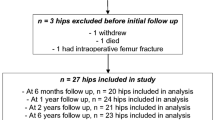Summary
Fifty-nine PCA cups and 61 hydroxyapatite-coated RM cups were included in a prospective randomised study with a mean follow up of 5.2 years. Clinical evaluation revealed better results with the RM cup. Radiological criteria of loosening could be applied only with considerable restrictions as different parameters were assessed: progressively loosened beads in PCA cups and faded contour in RM cups. Migration was measured by a computer assisted method (EBRA). PCA cups showed significantly more longitudinal migration 2 years after operation and subsequently. High migration values correlated with a limp. Loosening as defined by migration was of clinical relevance, could be measured early and predicted the survival rate.
Résumé
Cinquante-neuf cotyles PCA et 61 cotyles RM, recouverts d'hydroxyapatite, ont été rassemblés dans une étude prospective randomisée. La durée d'observation moyenne est de 5,2 ans. L'évaluation clinique, douleur, mobilité, marche, est en faveur du cotyle RM. Les critères radiologiques d'instabilité sont difficiles à apprécier, d'autant qu'il faut évaluer des paramètres différents: fragments progressivement libérés dans les cotyles PCA et irrégularités des contours dans les cotyles RM. Le déplacement a été étudié selon une nouvelle technique computérisée EBRA. Les cotyles PCA ont présenté une migration appréciable, surtout longitudinale, dès la 2ème année post-opératoire et ultérieurement une migration moyenne de 0,6 mm à 5 ans. Il existe une corrélation entre les déplacements importants et la boiterie. L'instabilité cotyloïdienne définie par le déplacement semble correspondre au résultat clinique, même à un stade précoce.
Similar content being viewed by others
References
Andersson G (1972) Hip assessment: a comparison of nine different methods. J Bone Joint Surg [Br] 54: 621–625
Bertin KC, Freeman MAR, Morscher E, Oeri A, Ring PA (1985) Cementless acetabular replacement using a pegged polyethylene prosthesis. Arch Orthop Trauma Surg 104: 251–261
Callaghan JJ, Dysart SH, Savory CG (1988) The uncemented porous-coated anatomic total hip prosthesis. J Bone Joint Surg [Am] 70: 337–346
Campbell ACL, Rorabeck CH, Bourne RB, Chess D, Nott L (1992) Thigh pain after cementless hip arthroplasty. Annoyance or ill omen. J Bone Joint Surg [Br] 74: 63–66
Gross M (1988) A critique of the methodologies used in clinical studies of hip — joint arthroplasty published in the english-language orthopaedic literature. J Bone Joint Surg [Am] 70: 1364–1371
Haddad RJ, Skalley TC, Cook SD, Brinker MR, Cheramie J, Meyer R, Missry J (1990) Clinical and roentgenographic evaluation of noncemented porous-coated anatomic locking (AML) and porous-coated anatomic (PCA) total hip arthroplasties. Clin Orthop 258: 176–182
Harris WH (1969) Traumatic arthritis of the hip after dislocation and acetabular fractures: treatment by mold arthroplasty. J Bone Joint Surg [Am] 51: 737–755
Hedley AK, Gruen TAW, Borden LS, Hungerford DS, Habermann E, Kenna RV (1987) Two-year follow-up of the PCA noncemented total hip replacement. The Proceedings of the 14th open scientific meeting of the Hip Society. Mosby, St. Louis, pp 225–250
Ilchmann T, Franzen H, Mjöberg B, Wingstrand H (1992) Measurement accuracy in acetabular cup migration: a comparison of four radiologic methods versus roentgen stereophotogrammetric analysis. J Arthroplasty 7: 121–127
Johnston RC, Fitzgerald RH, Harris WH, Poss R, Müller ME, Sledge CB (1990) Clinical and radiographic evaluation of total hip replacement: a standard system of terminology for reporting results. J Bone Joint Surg [Am] 72: 161–168
Krismer M, Fischer M, Klestil T, Frischhut B (1991) Uncoated polyethylene acetabular component versus Mueller cemented acetabular component. A 4- to 8-year follow-up study. Arch Orthop Trauma Surg 110: 195–199
Merle d'Aubigné R (1970) Cotation chiffrée de la fonction de la hanche. Rev Chir Orthop 56: 481–486
Mjöberg B, Brismar J, Hansson LI, Pettersson H, Selvik G, Önnerfält R (1985) Definition of endoprosthetic loosening: comparison of arthrography, scientigraphy and roentgen stereophotogrammetry in prosthetic hips. Acta Orthop Scand 56: 469–473
Mjöberg B, Selvik G, Hansson LI, Rosenqvist R, Önnerfält R (1986) Mechanical loosening of total hip prostheses: a radiographic and roentgen stereophotogrammetric study. J Bone Joint Surg [Am] 68: 770–774
Morscher EW (1991) Hydroxyapatite coating of prostheses. J Bone Joint Surg [Br] 73: 705–706
Morscher E, Dick W (1983) Cementless fixation of “isoelastic” hip endoprostesis manufactured from plastic materials. Clin Orthop 176: 77–87
Nunn D, Freeman MAR, Hill PF, Evans SJW (1989) The measurement of migration of the acetabular component of hip prosthesis. J Bone Joint Surg [Br] 71: 629–631
Russe W (1988) Röntgenphotogrammetrie der künstlichen Hüftgelenkspfanne. Huber, Bern
Russe W, Bauer R, Tschupik JP, Zaunschirm G, Mayer-hofer P (1986) Röntgenphotogrammetrie der RM-Pfanne. In: Refior HL, Hackenbroch MH, Wirth CJ (eds) Der alloplastische Ersatz der Hüftpfanne. Ergebnisse praxisbezogener Grundlagenforschung. 8. Münchner Symposion für experimentelle Orthopädie, pp. 179–190. Thieme, Stuttgart
Sutherland CJ, Wilde AH, Borden LS, Marks KE (1982) A ten-year follow-up of one hundred consecutive Müller curved-stem total hip-replacement arthroplasties. J Bone Joint Surg [Br] 64: 970–982
Wetherell RG, Amis AA, Heatley FW (1989) Measurement of acetabular erosion: the effect of pelvic rotation on common land marks. J Bone Joint Surg [Br] 71: 447–451
Wilson-MC Donald J, Morscher E, Masar Z (1990) Cementless uncoated polyethylene acetabular components in total hip replacement. Review of 5- to 10-year results. J Bone Joint Surg 72: 423–430
Author information
Authors and Affiliations
Rights and permissions
About this article
Cite this article
Krismer, M., Fischer, M., Mayrhofer, P. et al. A prospective study of the migration of two acetabular components. International Orthopaedics 18, 23–28 (1994). https://doi.org/10.1007/BF00180174
Accepted:
Issue Date:
DOI: https://doi.org/10.1007/BF00180174




